Effects of Wind Speed and Heat Flux on De-Icing Characteristics of Wind Turbine Blade Airfoil Surface
Abstract
:1. Introduction
- (1)
- There is a lack of detailed thermal effect during the de-icing process;
- (2)
- The de-icing mechanism of wind turbine blade surfaces under different wind speeds and heat fluxes has not been reported.
2. Model
2.1. Mathematical Model
2.1.1. Airflow Model
2.1.2. Droplet Flow Model
2.1.3. Water Film and Ice Accretion Model
2.1.4. Unsteady Conjugate Heat Transfer
2.2. Geometry and Computational Mesh
2.3. Boundary Condition and Solution Method
2.4. Model Validation
3. Results and Discussion
4. Conclusions
- When the de-icing time is 10 s with a heat flux of 10,000 W/m2, the peak ice thickness on the leading edge of the airfoil surface decreases from 0.28 mm to 0.068 mm, from 0.53 mm to 0.18 mm, and from 0.77 mm to 0.45 mm at wind speeds of 5 m/s, 10 m/s, and 15 m/s, respectively. The ice distribution range was reduced by 75%, 39.9%, and 25%, respectively.
- When the de-icing time is 10 s with a wind speed of 15 m/s, the peak ice thickness on the leading edge of the airfoil surface decreases by 31.2%, 41.6%, and 64.9% at a heat flux of 8000, 10,000, and 12,000 W/m2, respectively. Owing to an increase in surface temperature, the ice distribution range reduces by 16.1%, 25%, and 33.3%, respectively.
- With an increase in de-icing time, the peak thickness of runback ice increases. This is due to the fact that the water melted by ice accumulation at the leading edge moves backward under the action of inertial force, forming thicker ice on the surface where the surface temperature is below 273.15 K.
- The coverage range of runback ice decreases with an increase in heat flux due to the increase in surface temperature. The surface temperature in the ice-free area is significantly higher than that in the ice-melting area, due to high thermal resistance in the ice-free area.
Author Contributions
Funding
Informed Consent Statement
Data Availability Statement
Conflicts of Interest
Nomenclature
| chord length (m) | temperature (K) | ||
| the specific heat capacity of the water film (J/kg K) | the interface equilibrium temperature (°C) | ||
| the specific heat capacity of the ice (J/kg K) | velocity (m/s) | ||
| drag coefficient | the distance normal to the wall (m) | ||
| friction coefficient | |||
| characteristic length (m) | droplet volume fraction | ||
| thermal conduction coefficient (W/m K) | droplet collection efficiency | ||
| surface roughness (m) | emissivity | ||
| inertia parameter | dynamic viscosity (Pa s) | ||
| latent heat (J/kg) | shear stress (kg/m s2) | ||
| internal energy (J/kg) | |||
| Froude number | air | ||
| water film thickness (m) | droplet | ||
| internal enthalpy (J/kg) | evaporation | ||
| liquid water content (g/m3) | fusion | ||
| Reynolds number | water film | ||
| mass rate per unit area (kg/m2·s) | ice | ||
| heat flux (W/m2) | sublimation | ||
| gravity vector (m/s2) | free stream | ||
| time (s) | |||
References
- Tong, G.; Li, Y.; Tagawa, K.; Feng, F. Effects of blade airfoil chord length and rotor diameter on aerodynamic performance of straight-bladed vertical axis wind turbines by numerical simulation. Energy 2023, 265, 126325. [Google Scholar] [CrossRef]
- Xu, Z.; Zhang, T.; Lian, Y.; Feng, F. A parametric study on the effect of liquid water content and droplet median volume diameter on the ice distribution and anti-icing heat estimation of a wind turbine airfoil. Results Eng. 2024, 22, 102121. [Google Scholar] [CrossRef]
- Li, Y.; Sun, C.; Jiang, Y.; Yi, X.; Xu, Z.; Guo, W. Temperature effect on icing distribution near blade tip of large-scale horizontal-axis wind turbine by numerical simulation. Adv. Mech. Eng. 2018, 10, 1687814018812247. [Google Scholar] [CrossRef]
- Wang, C.; Lin, W.; Lin, X.; Wu, T.; Meng, Z.; Cai, A.; Xu, Z.; Li, Y.; Feng, F. The influence of angle of attack on the icing distribution characteristics of DU97 blade airfoil surface for wind turbines. Coatings 2024, 14, 160. [Google Scholar] [CrossRef]
- Stoyanov, D.B.; Nixon, J.D.; Sarlak, H. Analysis of derating and anti-icing strategies for wind turbines in cold climates. Appl. Energy 2021, 288, 116610. [Google Scholar] [CrossRef]
- Pryor, S.C.; Barthelmie, R.J. Climate change impacts on wind energy: A review. Renew. Sustain. Energy Rev. 2010, 14, 430–437. [Google Scholar] [CrossRef]
- Lamraoui, F.; Fortin, G.; Benoit, R.; Perron, J.; Masson, C. Atmospheric icing impact on wind turbine production. Cold Reg. Sci. Technol. 2014, 100, 36–49. [Google Scholar] [CrossRef]
- Zhang, L.; Gao, C.; Zhong, L.; Zhu, L.; Chen, H.; Hou, Y.; Zheng, Y. Robust photothermal superhydrophobic coatings with dual-size micro/nano structure enhance anti-/de-icing and chemical resistance properties. Chem. Eng. J. 2022, 446, 137461. [Google Scholar] [CrossRef]
- Liu, Z.; Feng, F.; Li, Y.; Sun, Y.; Tagawa, K. A corncob biochar-based superhydrophobic photothermal coating with micro-nano-porous rough-structure for ice-phobic properties. Surf. Coating. Technol. 2023, 457, 129299. [Google Scholar] [CrossRef]
- Zhang, L.-B.; Zhang, H.-X.; Liu, Z.-J.; Jiang, X.-Y.; Agathopoulos, S.; Deng, Z.; Gao, H.-Y.; Lu, H.-P.; Deng, L.-J.; Yin, L.-J. Nano-silica anti-icing coatings for protecting wind-power turbine fan blades. J. Colloid Interface Sci. 2023, 630, 1–10. [Google Scholar] [CrossRef]
- Wu, B.; Cui, X.; Jiang, H.; Wu, N.; Peng, C.; Hu, Z.; Liang, X.; Yan, Y.; Huang, J.; Li, D. A superhydrophobic coating harvesting mechanical robustness, passive anti-icing and active de-icing performances. J. Colloid Interface Sci. 2021, 590, 301–310. [Google Scholar] [CrossRef] [PubMed]
- Fan, B.; Jiang, L.; Zhou, Q.; Li, B. Research status and prospect of air-heating deicing technology for wind turbine blades. J. Eng. Therm. Energy Power 2023, 38, 1–9. [Google Scholar]
- Reid, T.; Baruzzi, G.S.; Habashi, W.G. FENSAP-ICE: Unsteady conjugate heat transfer simulation of electrothermal de-Icing. J. Aircr. 2012, 49, 1101–1109. [Google Scholar] [CrossRef]
- Xiao, C.; Yu, K.; Gui, Y.; Tang, Q. Analysis of parametric influence on phase change heat transfer characteristics of 1-D and 2-D electrothermal deicing. J. Aerosp. Power 2018, 33, 882–893. [Google Scholar]
- De Witt, K.J.; Keith, T.G.; Chao, D.F.; Masiulaniec, K. Numerical Simulation of Electrothermal Deicing Systems. In Proceedings of the AIAA 21st Aerospace Sciences Meeting, Reno, NV, USA, 10–13 January 1983. [Google Scholar]
- Xiao, C.; Lin, G.; Gui, Y.; Xiao, J. Study on effect of ice shedding on heat transfer characteristics of electrothermal aircraft deicing. Acta Aerodyn. Sin. 2012, 30, 551–556. [Google Scholar]
- Chang, S.; Ai, S.; Huo, X.; Yuan, X. Improved simulation of electrothermal de-icing system. J. Aerosp. Power 2008, 23, 1753–1758. [Google Scholar]
- Shen, X.; Wang, H.; Lin, G.; Bu, X.; Wen, D. Unsteady simulation of aircraft electro-thermal deicing process with temperature-based method. Proc. Inst. Mech. Eng. Part G J. Aerosp. Eng. 2020, 234, 388–400. [Google Scholar] [CrossRef]
- Mu, Z.; Lin, G.; Shen, X.; Bu, X.; Zhou, Y. Numerical simulation of unsteady conjugate heat transfer of electrothermal deicing process. Int. J. Aerosp. Eng. 2018, 2018, 1–16. [Google Scholar] [CrossRef]
- Zhu, C.-X.; Wang, Y.; Zhao, N.; Zhu, C.-L.; Liu, C.-Y. Numerical simulation and experimental verification of the airfoil electrothermal deicing system performance. J. Chin. Inst. Eng. 2021, 44, 608–617. [Google Scholar] [CrossRef]
- Fu, J.; Zhuang, W.; Yang, B.; Chang, S. Simulation of heating control law of electro-thermal deicing of helicopter rotor blade. J. Beijing Univ. Aeronaut. Astronaut. 2014, 40, 1200–1207. [Google Scholar]
- Pourbagian, M.; Habashi, W.G. Aero-thermal optimization of in-flight electro-thermal ice protection systems in transient de-icing mode. Int. J. Heat Fluid Flow 2015, 54, 167–182. [Google Scholar] [CrossRef]
- Xiao, C.-H.; Lin, G.-P.; Gui, Y.-W.; Xiao, J.-P. Study on coupled thermo-mechanical characteristic and its effects during the process of electrothermal deicing. J. Exp. Fluid Mech. 2012, 26, 23–28. [Google Scholar]
- Lei, G.; Dong, W.; Zhu, J.; Zheng, M. A new melting model in electrothermal de-icing simulation. In Proceedings of the ASME Turbo Expo 2015: Turbine Technical Conference and Exposition, Montreal, QC, Canada, 15–19 June 2015. [Google Scholar]
- Henry, R. Development of an Electrothermal Deicing/Anticing mode. In Proceedings of the 30th Aerospace Sciences Meeting & Exhibit, Reno, NV, USA, 15–18 January 1992. [Google Scholar]
- Shu, L.; Qiu, G.; Hu, Q.; Jiang, X.; McClure, G.; Yang, H. Numerical and field experimental investigation of wind turbine dynamic de-icing process. J. Wind. Eng. Ind. Aerodyn. 2018, 175, 90–99. [Google Scholar] [CrossRef]
- Valerie, P. Numerical Modeling of an Electrothermal System for Deicing Horizontal Axis Wind Turbine Blades; Ecole Polytechnique: Montreal, QC, Canada, 1998. [Google Scholar]
- Shu, L.; Qiu, G.; Hu, Q.; Jiang, X.; McClure, G.; Liu, Y. Numerical Model and Field Experimental Investigation of Threshold Heat Flux of Wind Turbine De-icing. Proc. Chin. Soc. Electr. Eng. 2018, 38, 3997–4003. [Google Scholar]
- Xu, Z.; Zhang, T.; Li, X.; Li, Y. Effects of ambient temperature and wind speed on icing characteristics and anti-icing energy demand of a blade airfoil for wind turbine. Renew. Energy 2023, 217, 119135. [Google Scholar] [CrossRef]
- Hannat, R.; Morency, F. Numerical validation of conjugate heat transfer method for anti-/de-icing piccolo system. J. Aircraft 2014, 51, 104–116. [Google Scholar] [CrossRef]
- Ahn, G.B.; Jung, K.Y.; Myong, R.S.; Shin, H.B.; Habashi, W.G. Numerical and experimental investigation of ice accretion on rotorcraft engine air intake. J. Aircr. 2015, 52, 903–909. [Google Scholar] [CrossRef]
- Clift, R.; Grace, J.R.; Weber, M.E. Bubbles, Drops, and Particles; Academic Press: New York, NY, USA, 1978. [Google Scholar]
- Beaugendre, H.; Morency, F.; Habashi, W.G. Development of a second generation in-flight icing simulation code. J. Fluids Eng. 2006, 128, 378–387. [Google Scholar] [CrossRef]
- Fouladi, H.; Habashi, W.G.; Ozcer, I.A. Quasi-steady modeling of ice accretion on a helicopter fuselage in forward flight. J. Aircr. 2013, 50, 1169–1178. [Google Scholar] [CrossRef]
- Tompson, B.E.; Marrochello, M.R. Rivulet formation in surface-water flow on an airfoil in rain. AIAA J. 1999, 37, 45–49. [Google Scholar] [CrossRef]
- Beaugendre, H.; Morency, F.; Habashi, W.G.; Benquet, P. Roughness implementation in FENSAP-ICE: Model calibration and influence on ice shapes. J. Aircr. 2003, 40, 1212–1215. [Google Scholar] [CrossRef]
- Reid, T.; Baruzzi, G.; Aliaga, C.; Aubé, M. FENSAP-ICE: Application of Unsteady CHT to De-icing Simulations on a Wing with Inter-Cycle Ice Formation. AIAA 2010, 2010, 7835. [Google Scholar]
- Battisti, L. Wind Turbines in Cold Climates; Springer: Berlin/Heidelberg, Germany, 2015. [Google Scholar]
- Al-Khalil, K.; Horvath, C.; Miller, D.; Aubé, M.; Habashi, W. Validation of NASA thermal ice protection computer codes: Part 3: The validation of ANTICE. In Proceedings of the 35th Aerospace Sciences Meeting and Exhibit, Reno, NV, USA, 6–10 January 1997; American Institute of Aeronautics and Astronautics: Reston, VA, USA, 1997. [Google Scholar]
- Zhong, G. Simulation of Airfoil Electro-Thermal Anti-Ice/De-Ice System. Aeronaut. Manuf. Technol. 2011, 4, 75–79. [Google Scholar]

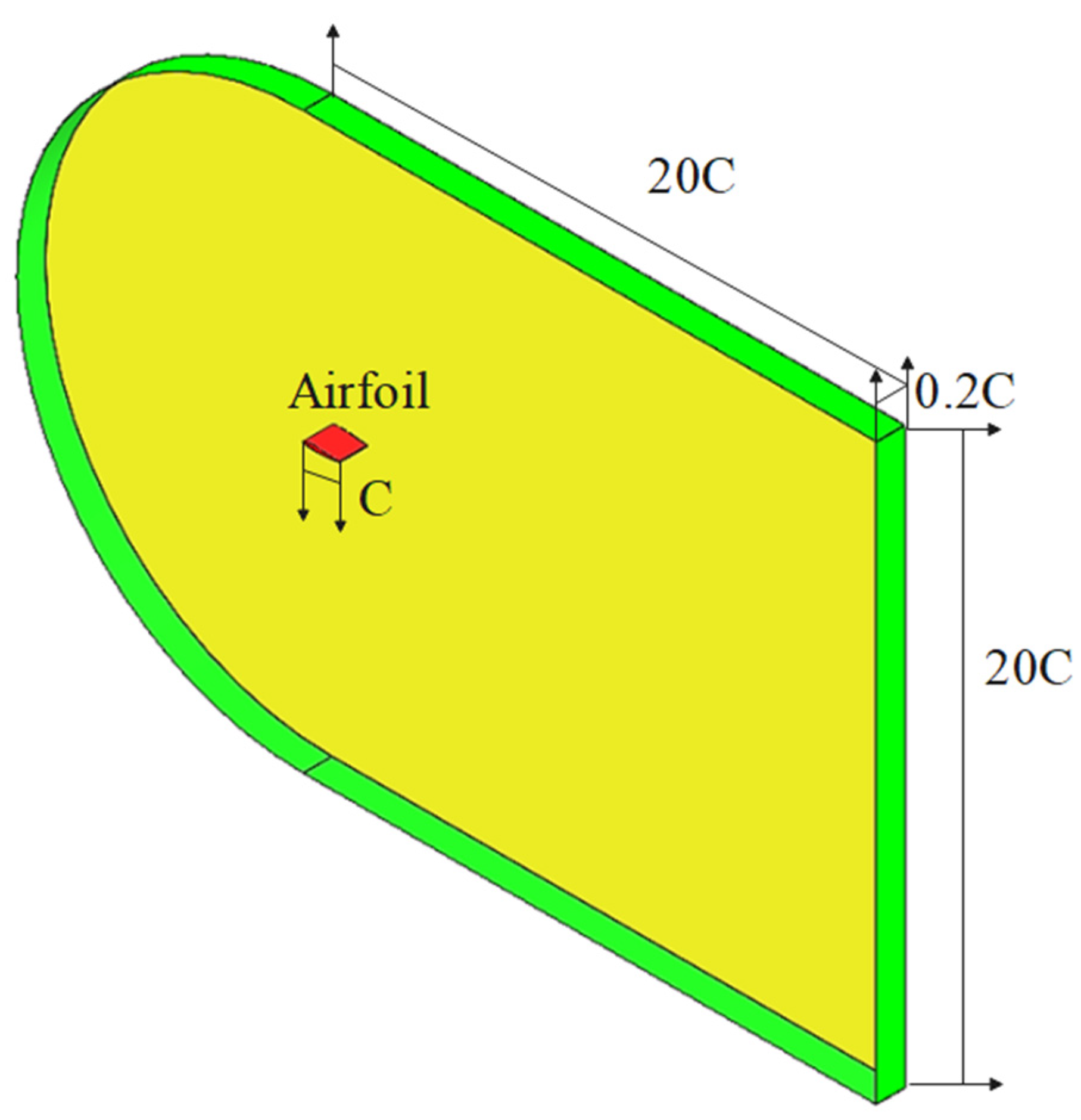


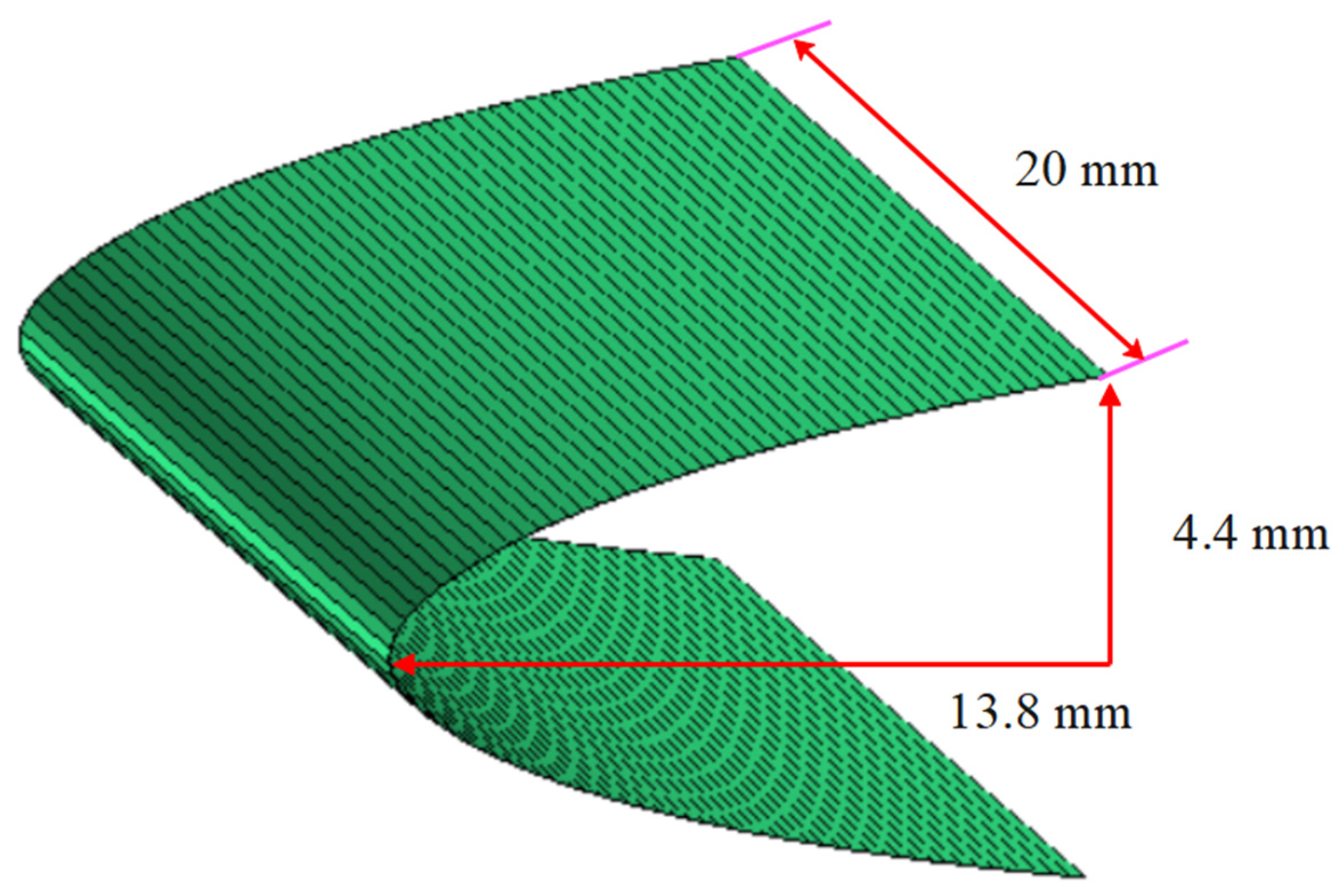


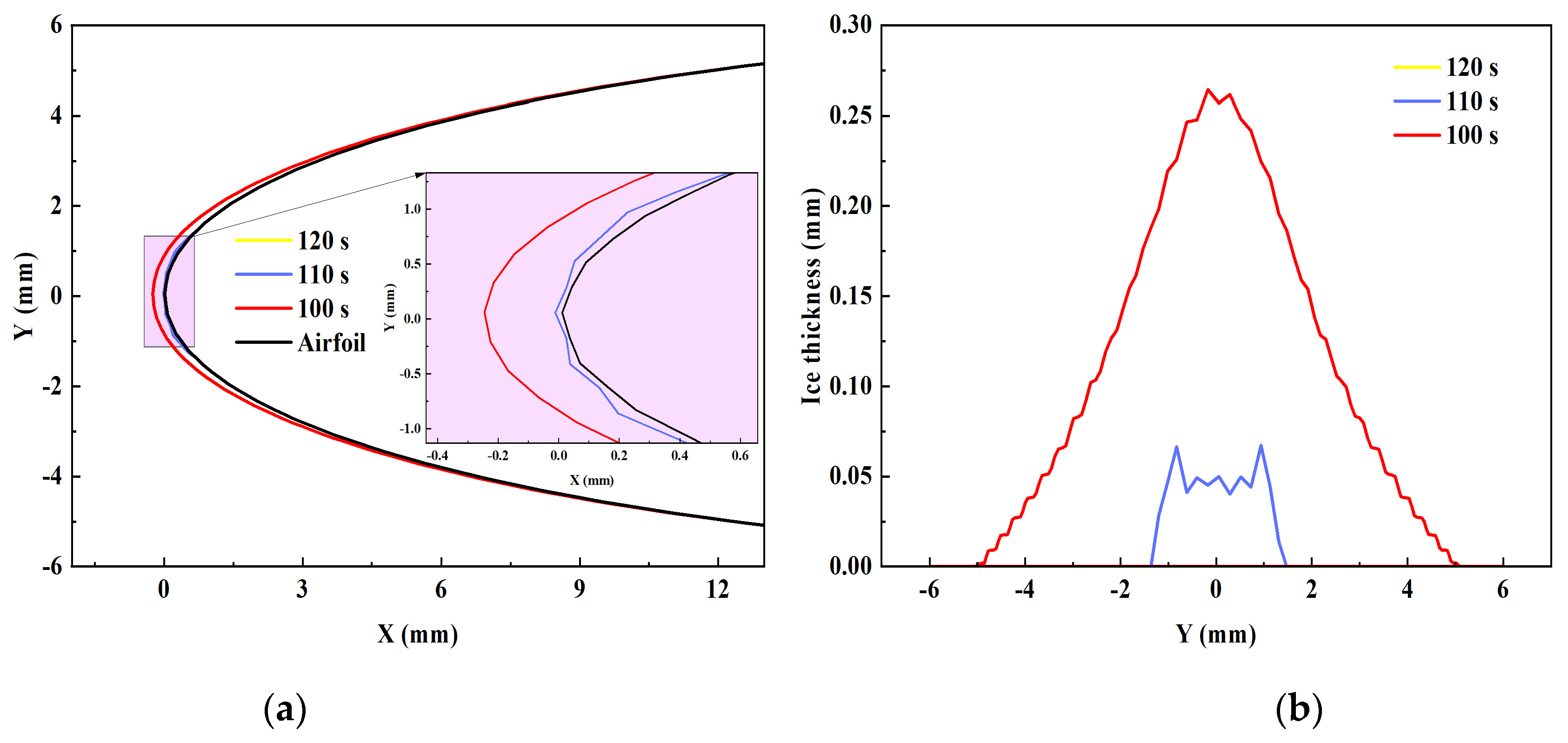


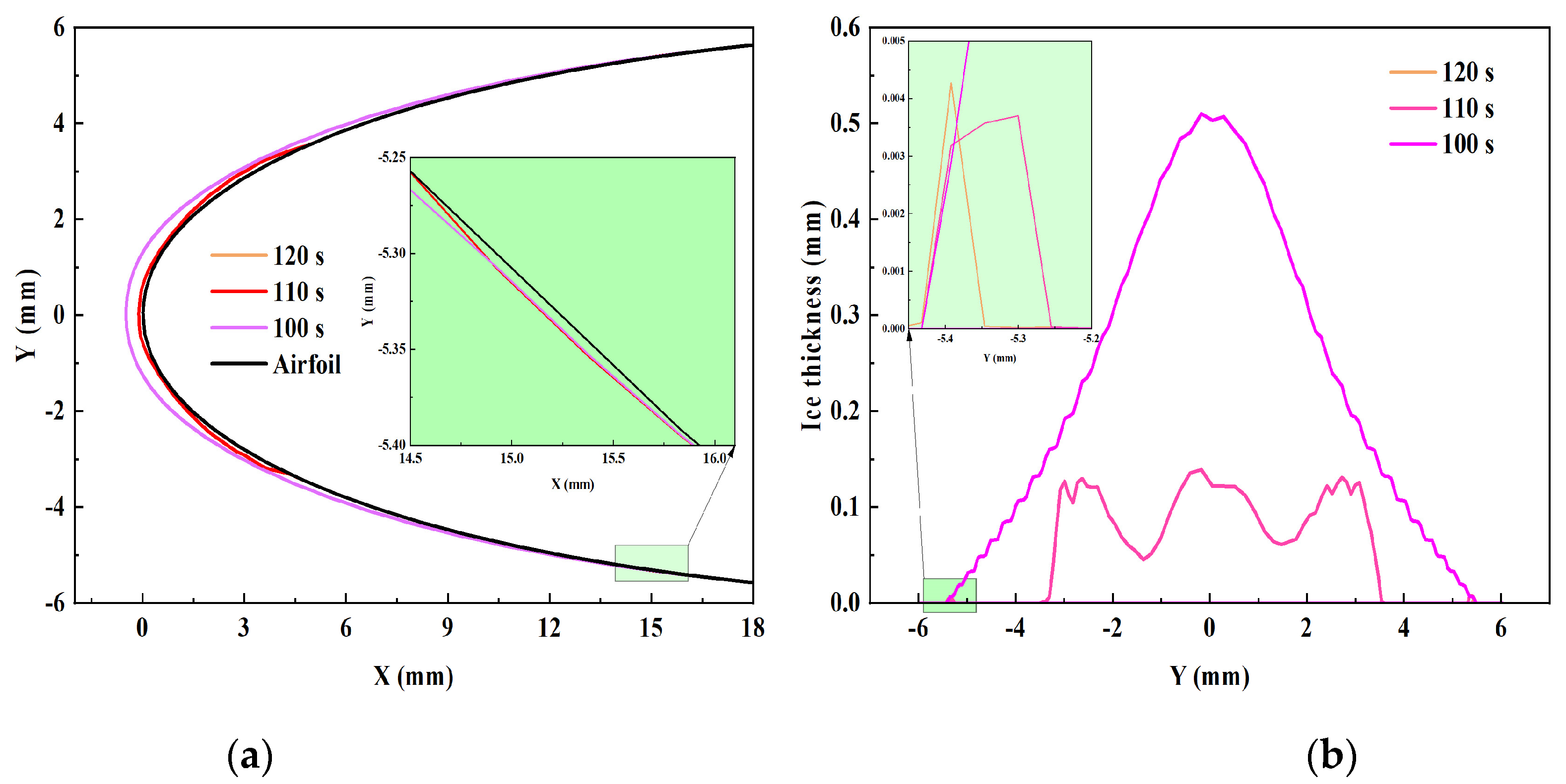
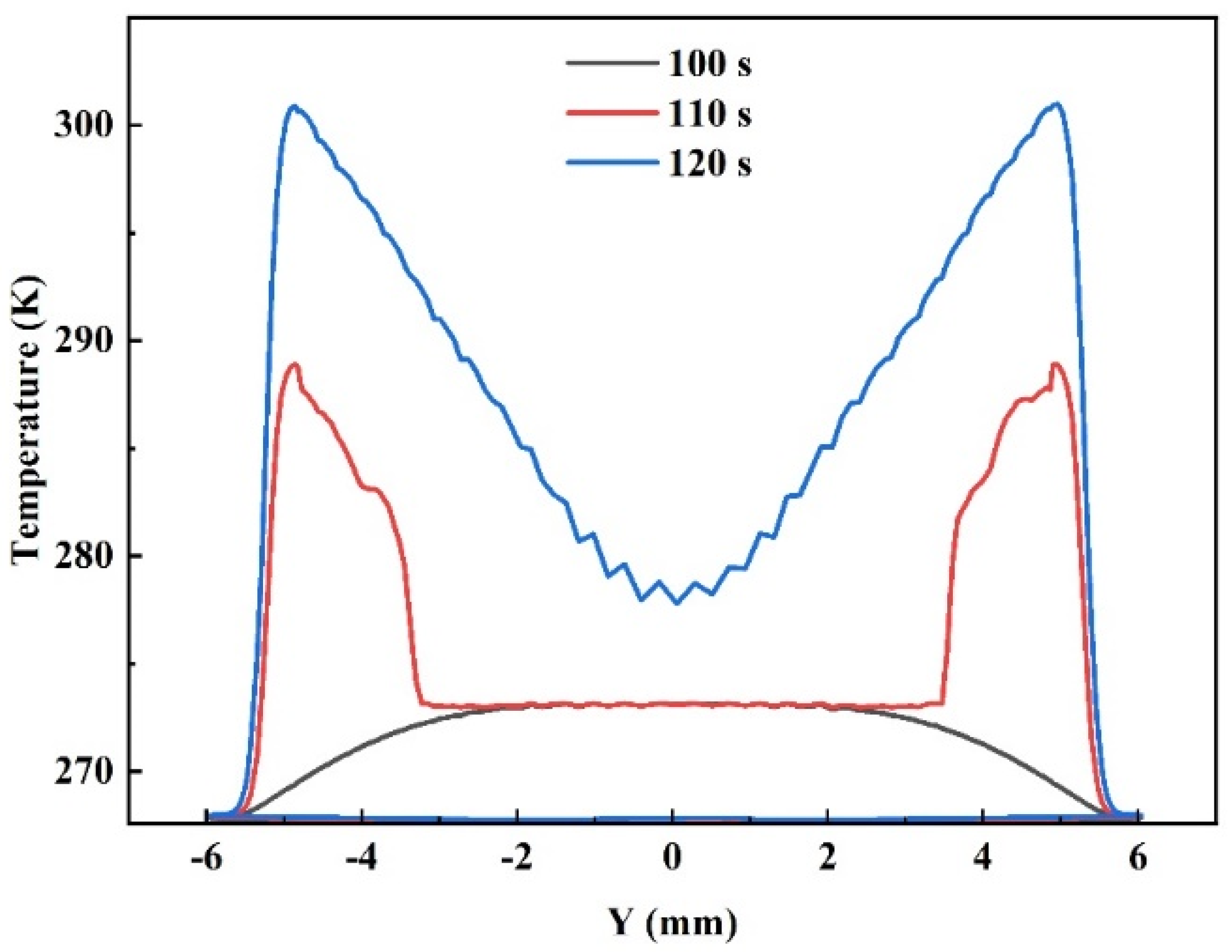

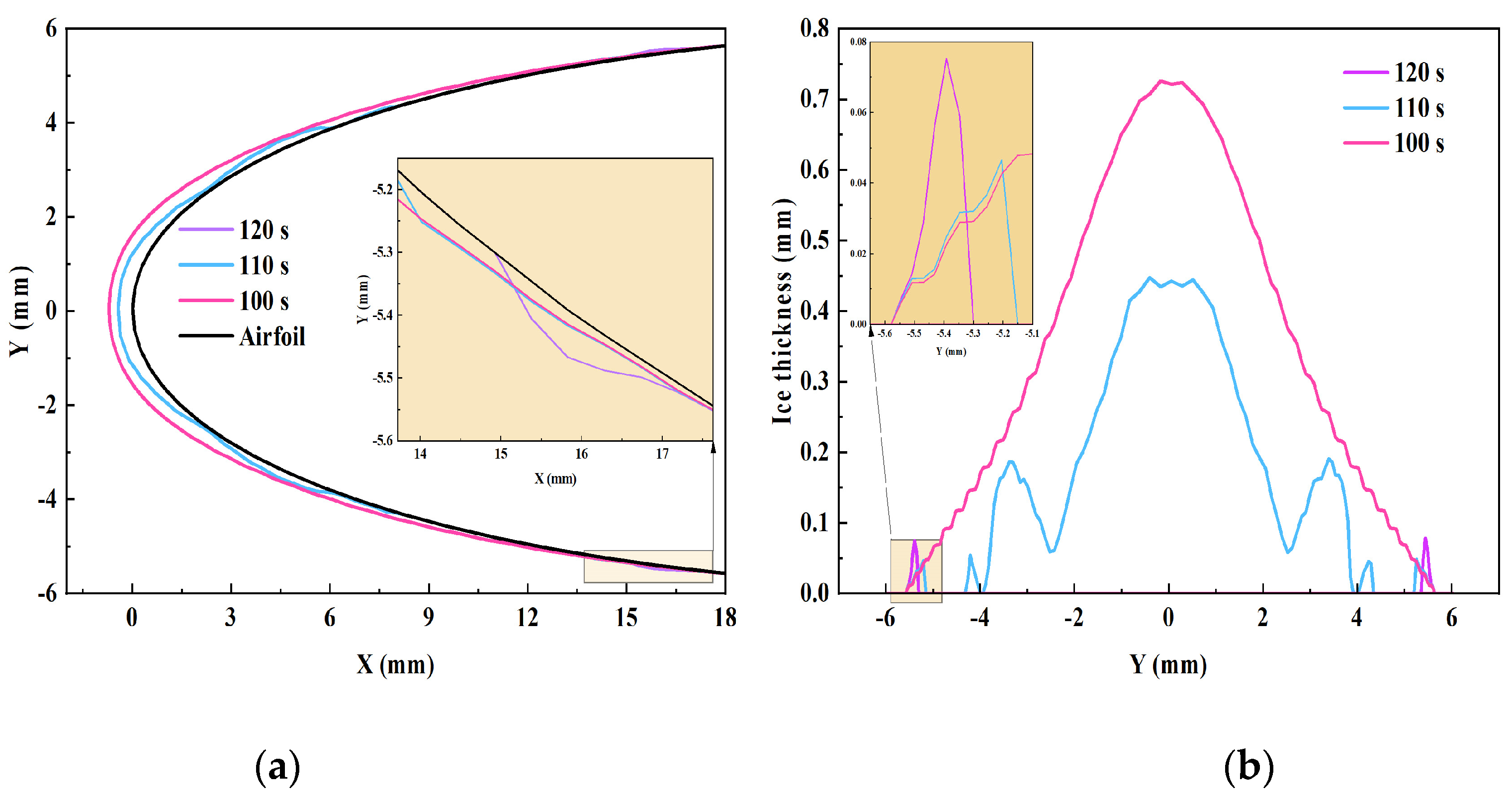
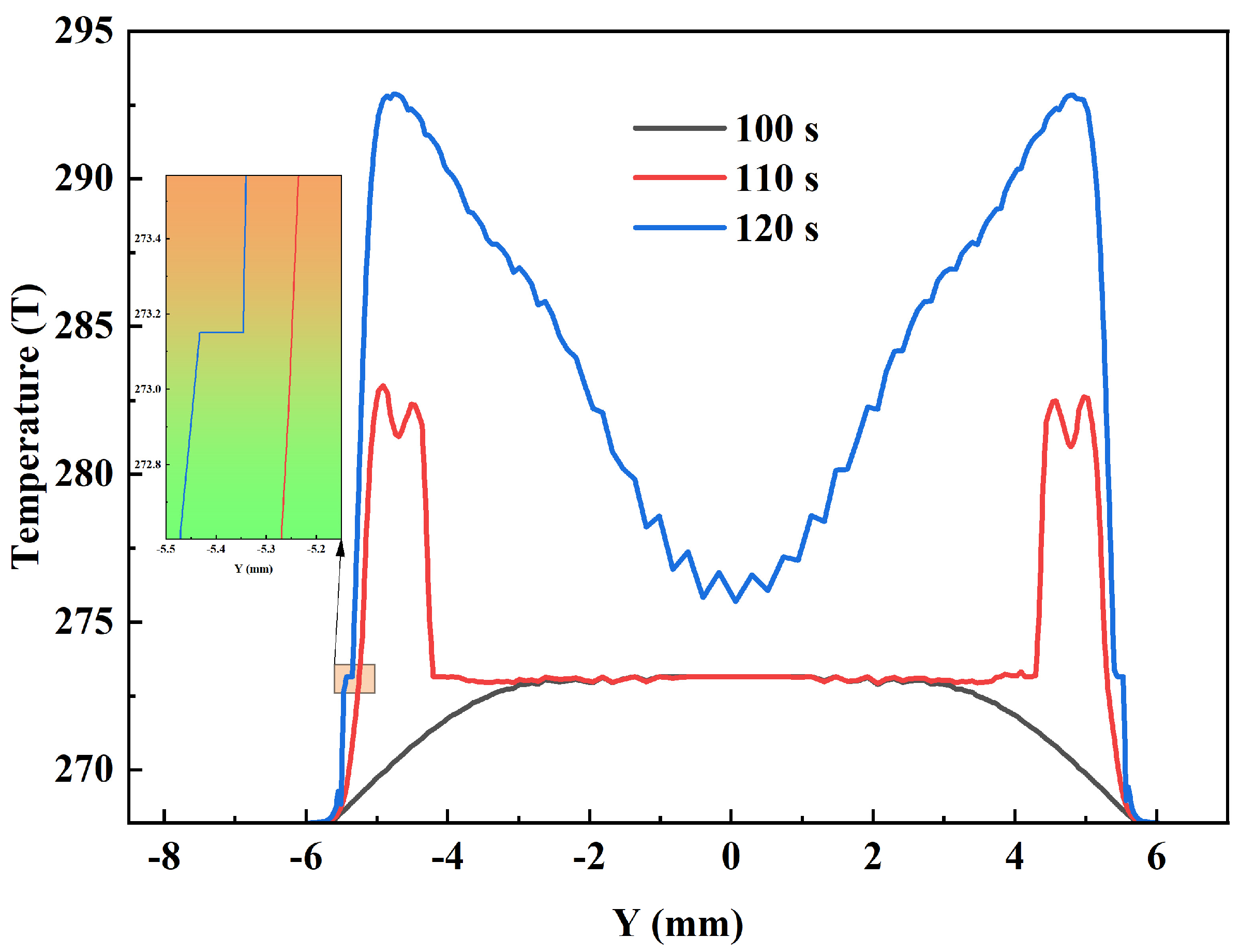
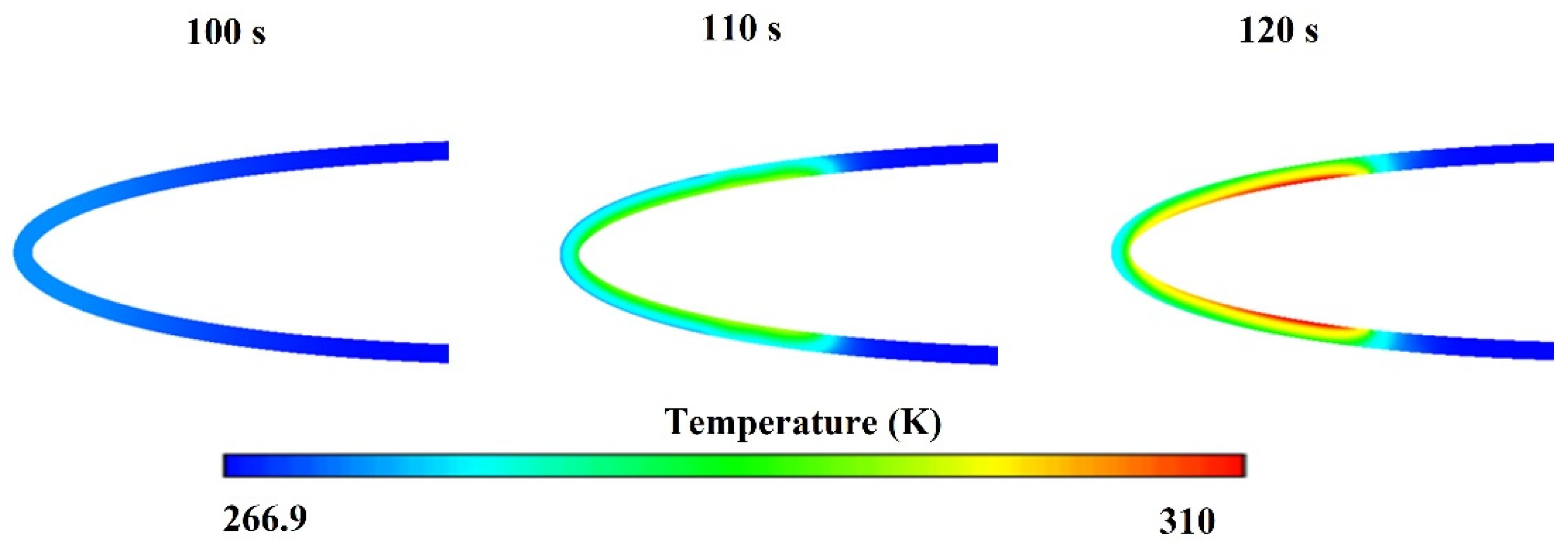


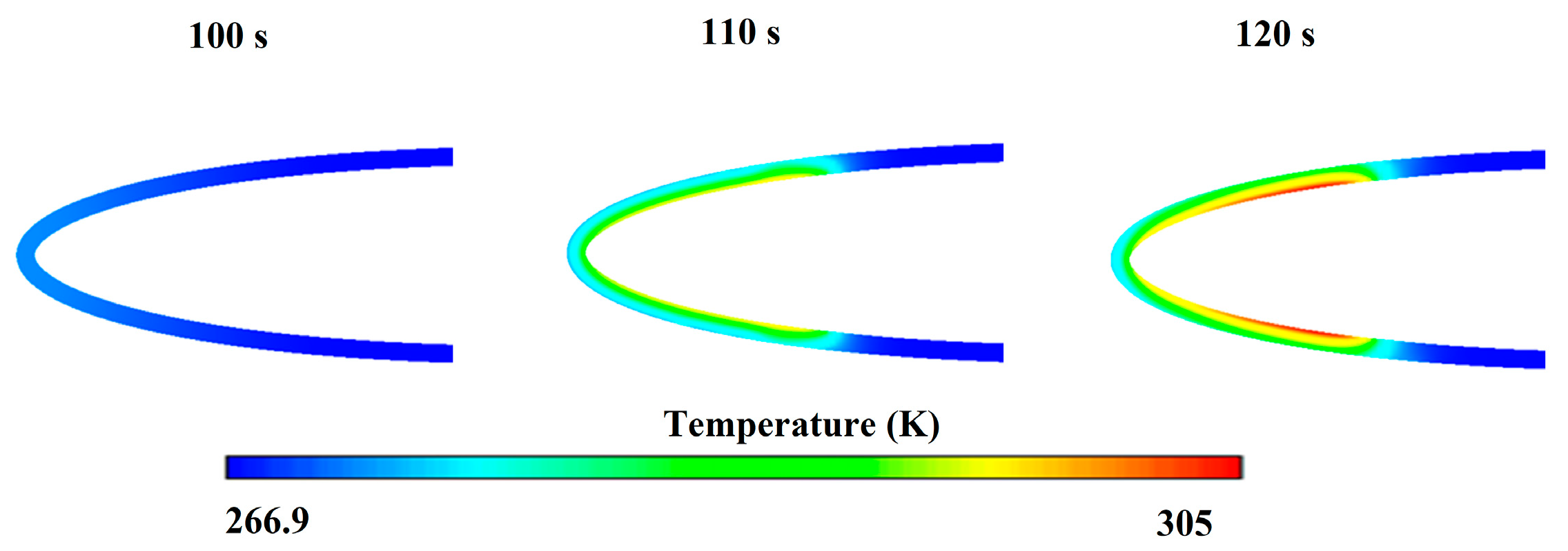
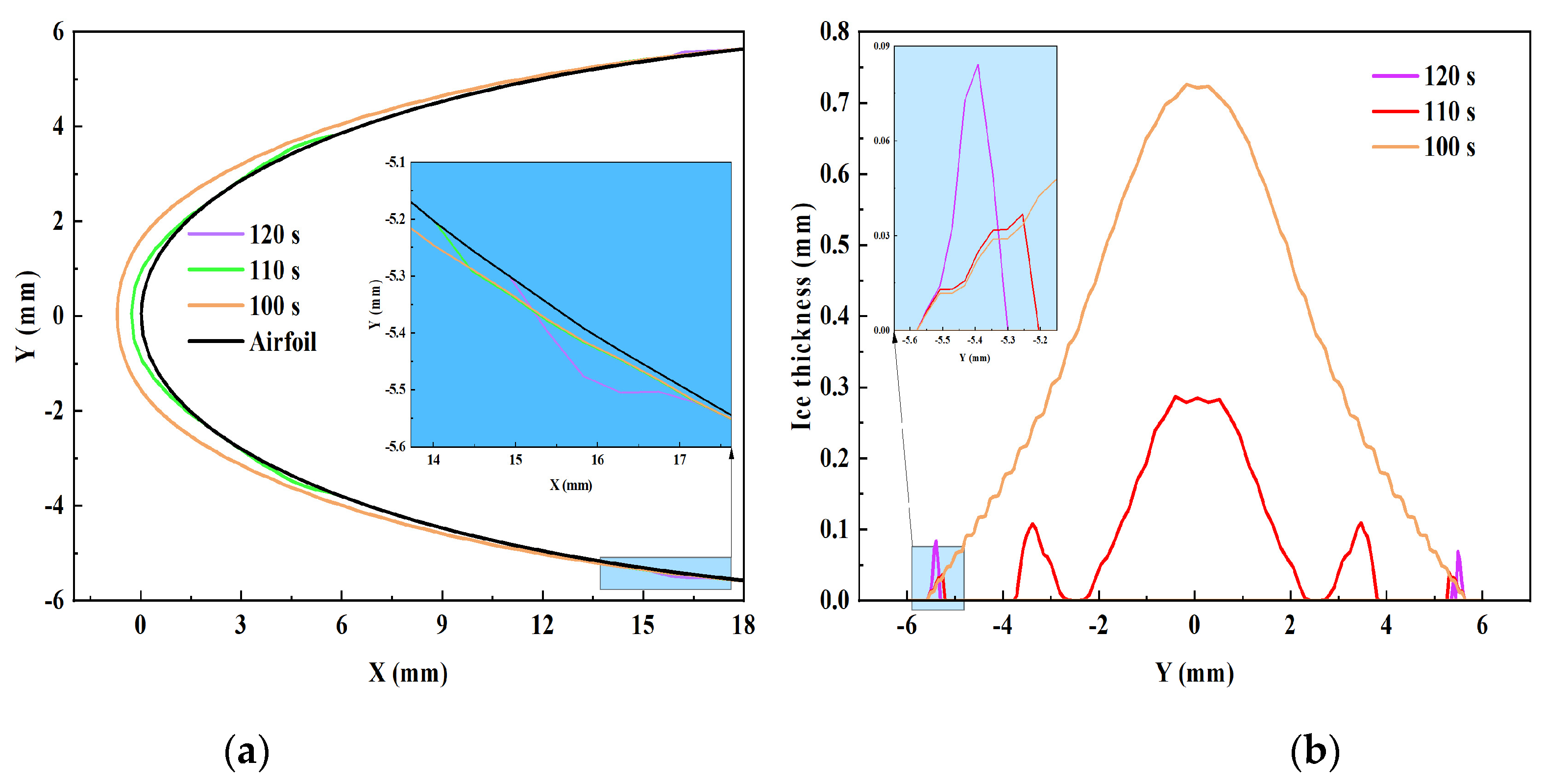
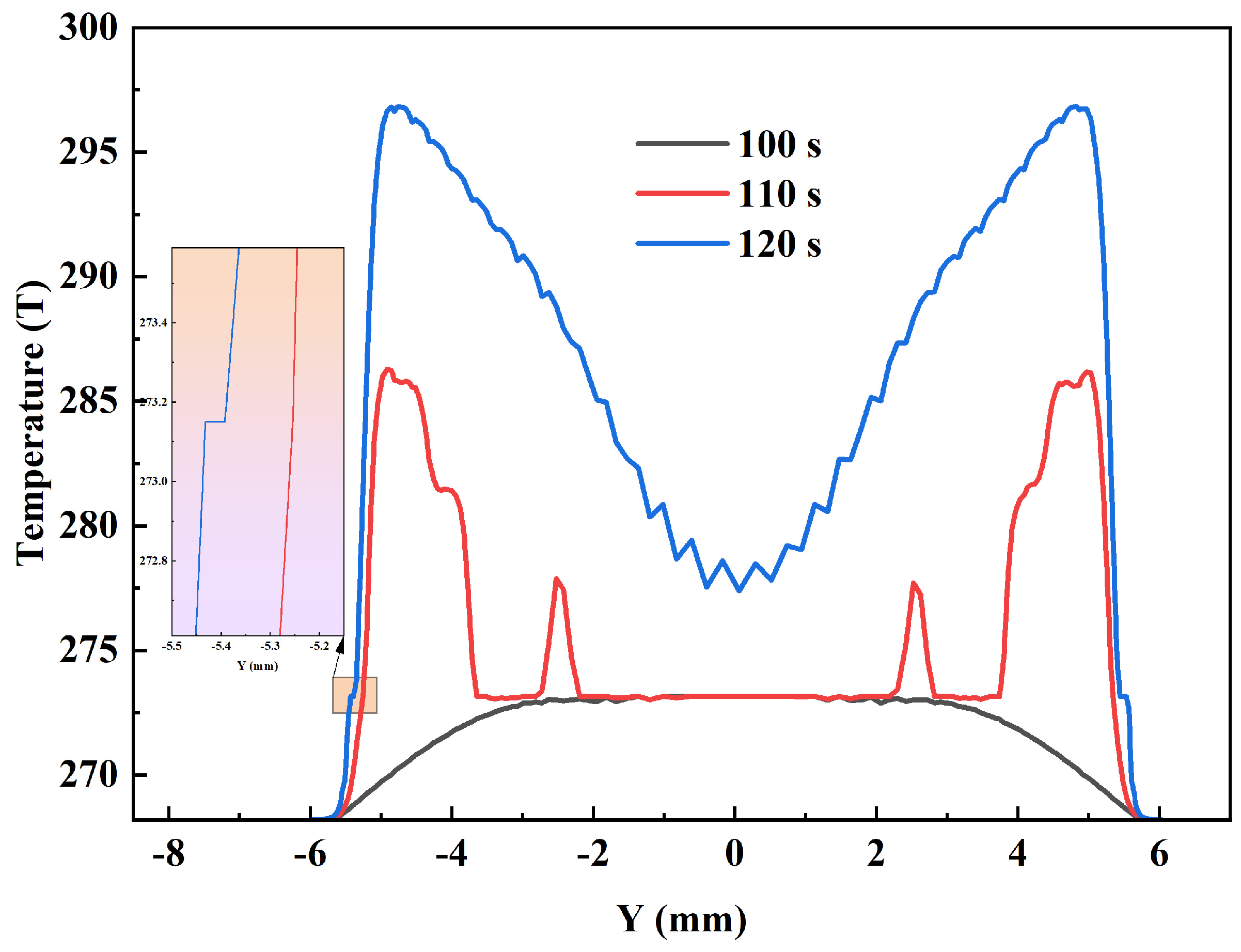
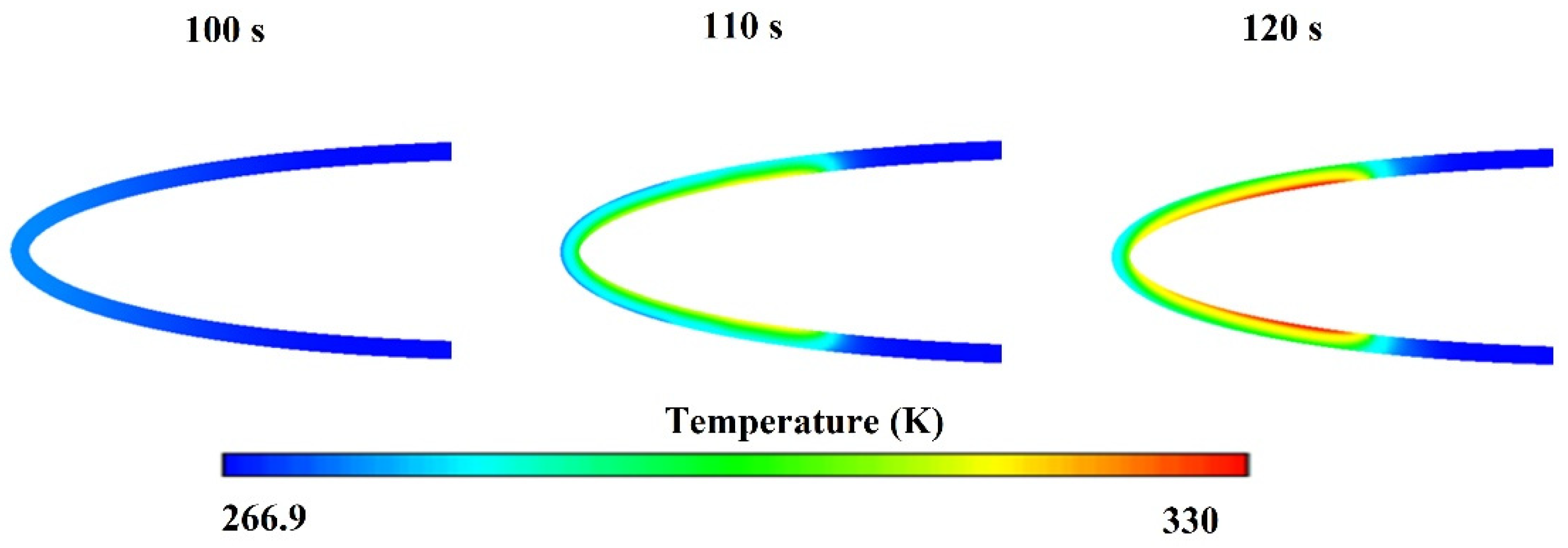

| Material | Density (kg m−3) | Thermal Conductivity (W m−1 K−1) | Heat Capacity (J kg−1 K−1) |
|---|---|---|---|
| Fiberglass | 1794 | 0.294 | 1570.1 |
| Types | Values |
|---|---|
| Far field | Pressure: 101,325 Pa Temperature: 268 K LWC: 0.6 g/m3 MVD: 50 μm Speed: 5~15 m/s |
| Wall | No slip |
| Case | Wind Speed (m/s) | Heat Flux (W/m2) | Other Conditions |
|---|---|---|---|
| 1 | 5 | 10,000 | Temperature: 268 K Liquid water content: 0.6 g/m3 Medium volume diameter: 50 μm Angle of attack: 0° Total de-icing time: 120 s |
| 2 | 10 | 10,000 | |
| 3 | 15 | 10,000 | |
| 4 | 15 | 8000 | |
| 5 | 15 | 12,000 |
| Time | 0~100 s | 100~120 s |
|---|---|---|
| Heat flux | 0 W/m2 | 8000/10,000/12,000 W/m2 |
Disclaimer/Publisher’s Note: The statements, opinions and data contained in all publications are solely those of the individual author(s) and contributor(s) and not of MDPI and/or the editor(s). MDPI and/or the editor(s) disclaim responsibility for any injury to people or property resulting from any ideas, methods, instructions or products referred to in the content. |
© 2024 by the authors. Licensee MDPI, Basel, Switzerland. This article is an open access article distributed under the terms and conditions of the Creative Commons Attribution (CC BY) license (https://creativecommons.org/licenses/by/4.0/).
Share and Cite
Zhang, T.; Lian, Y.; Xu, Z.; Li, Y. Effects of Wind Speed and Heat Flux on De-Icing Characteristics of Wind Turbine Blade Airfoil Surface. Coatings 2024, 14, 852. https://doi.org/10.3390/coatings14070852
Zhang T, Lian Y, Xu Z, Li Y. Effects of Wind Speed and Heat Flux on De-Icing Characteristics of Wind Turbine Blade Airfoil Surface. Coatings. 2024; 14(7):852. https://doi.org/10.3390/coatings14070852
Chicago/Turabian StyleZhang, Ting, Yangyang Lian, Zhi Xu, and Yan Li. 2024. "Effects of Wind Speed and Heat Flux on De-Icing Characteristics of Wind Turbine Blade Airfoil Surface" Coatings 14, no. 7: 852. https://doi.org/10.3390/coatings14070852




